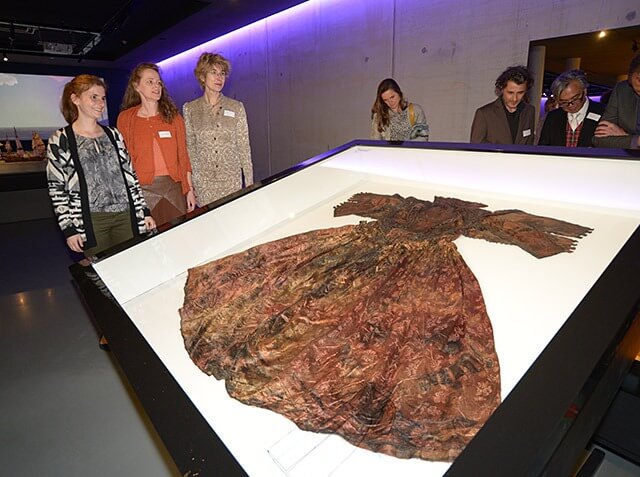
Please note: this is a news item from 2016. The information below is therefore (partly) no longer up-to-date.
‘We have seldom – perhaps even never – witnessed a find of this scale in a maritime context,’ says Professor Maarten van Bommel of the University of Amsterdam. The items, which were found at the wreck of a 17th-century ship in the Wadden Sea near Texel, include a very luxurious gown that has remained remarkably well preserved. This gown serves as the centrepiece of the temporary exhibition ‘Garde Robe’, which opened at museum Kaap Skil today.
Valuable find
The gown, which due to its rich embellishments is believed to belong to ‘a nobleman, possibly even a member of the royal family’ is part of an extensive wardrobe. Among other articles, the site yielded a cloak, stockings and silk and satin bodices decorated with large quantities of gold and silver thread. In addition to textiles, the divers also found practical items like pottery from Italy, a gilded silver chalice and scents from Greece or Turkey. In addition, a number of book covers emerged from the depths that bear the coat of arms of the English Royal House of Stuart.
International importance
Experts from the Rijksmuseum, the University of Amsterdam and the Cultural Heritage Agency (RCE) view the recovered textiles as one of Europe’s most important clothing finds ever. Their discovery in combination with other objects make this one of the foremost and most appealing finds in the history of Dutch archaeology. Since everything in a ship’s wreck is preserved in one collection – like a time capsule – this find will offer us tremendously detailed insights into what it was like to live and work on board the vessel, what the contemporary trade connections were and what the political situation of the time was.
The wrecks of the Texel Roadstead
The seabed along the coast of the island of Texel, near Oudeschild, is littered with hundreds of ship’s wrecks, including from the 17th century. Here, ships waiting for cargo or favourable sailing conditions would regularly founder due to storms and bad weather. The vessels and their contents were often well preserved under the sandy sea floor. The changing currents along the seabed occasionally uncover a wreck, so that the cargo risks becoming damaged or dispersed. Various organisations responsible for preserving these sites are currently investigating how best to deal with these processes. They are working together in this context with the Texel Diving Club, which called attention to this find.
Exhibition opening
The exhibition ‘Garde Robe’ was opened on Thursday, 14 April, on behalf of all parties involved, by Jack van der Hoek, Member of the Provincial Executive of North Holland. The spectacular opening was directed by Studio Aziz Bekkaoui. Museum Kaap Skil is tremendously proud to present a selection of the objects found at the wreck to the public for a full month. The exhibition will run until Monday, 16 May 2016. After this, the items will be transferred to North Holland’s archaeological centre Hilde’s House, where they will be studied further. The University of Amsterdam, RCA and the Rijksmuseum will be closely involved in this research. The Province of North Holland, which has become the formal owner of the find, will be bearing responsibility for the study. Ultimately, the find will be returned to museum Kaap Skil on Texel for exhibition.


